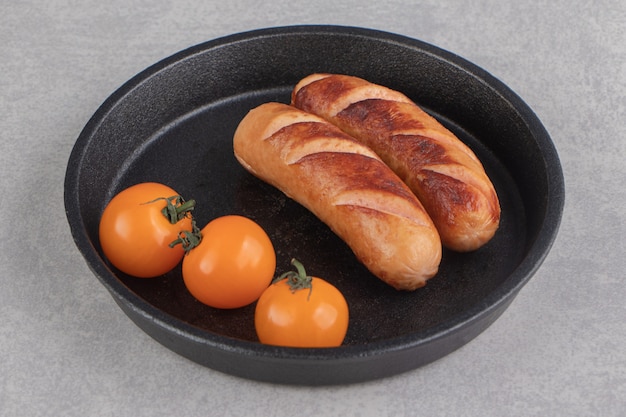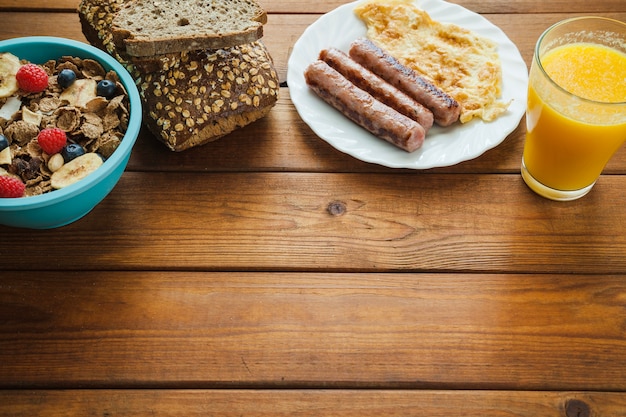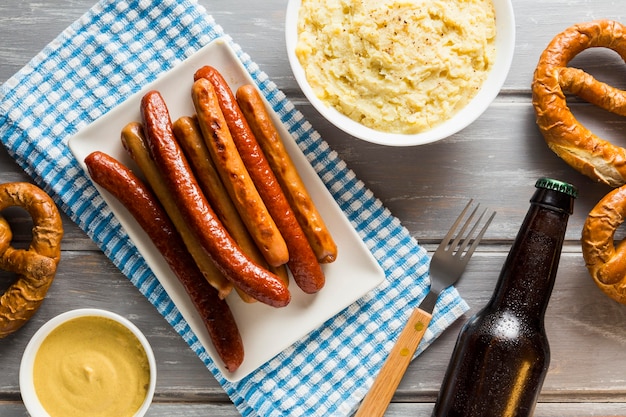(Part 1) Choosing the Right Sausage

The Sausage Spectrum: A culinary adventure Awaits
The first step on your sausage journey is picking the right links for your culinary adventure. The world of breakfast sausage is incredibly diverse, offering a range of flavors, textures, and even casings to suit every taste and cooking style. It's like picking your team for a breakfast showdown—you want sausages that are going to play well with the rest of your ingredients and create a delicious harmony on your plate.
pork sausage: The Classic Choice
Pork sausage is a classic for a reason! It has that rich, satisfying flavor that simply screams "breakfast." You can find pork sausage in a spectrum of styles, from mild to spicy, often with added herbs and spices that enhance the flavor. For a novice sausage chef, pork sausage is a great place to start.
I remember my first foray into breakfast sausage cooking. I was a young, eager (but somewhat clueless) cook, and I opted for a mild pork sausage. It was a simple but satisfying start to my sausage journey. The mild flavor allowed the other breakfast components to shine, and it was a great foundation for learning how to cook sausages properly.
Turkey Sausage: The Leaner Option
If you're looking for a lighter option without sacrificing flavor, turkey sausage is a fantastic choice. It's lower in fat and calories than pork sausage, making it a great option for those who are watching their waistline. However, turkey sausage can sometimes be a little dry, so I often add a bit of fat to the pan to help keep it moist and juicy. A drizzle of olive oil or a pat of butter does the trick!
Chicken Sausage: A Versatile Delight
Chicken sausage is another great option for those looking to experiment with different flavors. It has a milder flavor than pork sausage, making it extremely versatile. You can find chicken sausage in a range of styles, from classic breakfast flavors to Italian-inspired varieties. I personally love a good chicken sausage with a citrusy marinade or a touch of lemon zest – it adds a bright, fresh flavor that’s perfect for a lighter breakfast.
Beyond the Basics: Embracing Sausage Variety
The world of sausage is truly vast and exciting! You can find sausages made from lamb, veal, or even bison if you’re feeling adventurous. There's also a world of flavorful sausages to explore, from apple sausage with its sweet, fruity notes to spicy chorizo and smoky bratwurst. Don’t be afraid to experiment and find your favorite!
The Casing Conundrum: Natural vs. Artificial
Now, let's talk about casings. You have your natural casings, which are made from animal intestines, and artificial casings made from cellulose or collagen. I personally prefer natural casings. They give the sausage a bit more texture and chew, and that "snap" when you bite into them. However, they can be a bit more delicate to handle. If you’re looking for something more user-friendly, artificial casings are a good choice. Just be careful not to crank up the heat too high, as the artificial casing can split open if it gets too hot.
(Part 2) Preparing the Sausage for Cooking

The Great Sausage Defrost: Patience is Key
The first step in your sausage journey is thawing them properly. Never, ever cook sausage links straight from frozen. It’s a recipe for disaster – you'll end up with uneven cooking and a rubbery texture. A big no-no!
The safest and most reliable method for thawing sausage is to do it slowly in the refrigerator overnight. This gentle thawing allows the sausage to defrost evenly and retain its moisture, resulting in a more tender and flavorful final product.
If you find yourself in a time crunch, you can defrost the sausage in cold water. Just be sure to change the water every 30 minutes or so to maintain a low temperature and prevent bacteria growth. But let’s be honest, a quick defrost isn't as good as a slow, gentle thaw.
The Importance of Patting Dry: A Little Detail Makes a Big Difference
Once your sausages are thawed, pat them dry with paper towels. This might seem like a small step, but it's essential for achieving that perfect, golden-brown crisp. Excess moisture on the surface of the sausage can lead to steaming, which prevents the sausages from browning properly.
Remember, a little extra effort in the preparation stage goes a long way in achieving a delicious, perfectly cooked sausage.
The Pre-Seasoning Advantage: Adding Your Personal Touch
Many sausages are pre-seasoned, but don’t be afraid to add your own personal touch! If you're feeling adventurous, experiment with pre-seasoning your sausages with your favorite spices and herbs. A sprinkle of paprika for a smoky kick, a touch of garlic powder for a savory aroma, or even a dash of oregano for a hint of Mediterranean flair can really elevate the flavor.
You can also rub the sausages with a little olive oil or butter before cooking to help them brown beautifully. Just be mindful not to overdo it – you don't want a greasy mess!
(Part 3) Cooking Methods: A Guide to Your culinary arsenal

The Stovetop Sizzle: A Classic Choice
For many cooks, the stovetop is the go-to method for cooking breakfast sausage. It’s simple, straightforward, and offers great control over the cooking process. Here's how to master the stovetop sizzle:
- Heat a large skillet over medium heat. You don't want the pan too hot, or the sausages will burn before they have a chance to cook through.
- Add a tablespoon or two of oil to the skillet. You can use any type of oil you like, but I prefer to use neutral oils like canola or vegetable oil. They have a high smoke point and won’t overpower the flavor of the sausage.
- Place the sausage links in the skillet, leaving a little space between each one. Don’t overcrowd the pan – this will prevent the sausages from cooking evenly.
- Cook the sausages for about 8-10 minutes per side, or until they are golden brown and cooked through. Make sure you flip them frequently to ensure even browning and prevent sticking. A meat thermometer is your best friend here – aim for an internal temperature of 160°F (71°C).
The Oven's Gentle Touch: Perfect for Large Batches
The oven is another great option for cooking breakfast sausage, especially if you're cooking a large batch. It's a more hands-off approach, allowing you to attend to other breakfast tasks while the sausages cook. Here's how to bake sausage to perfection:
- Preheat your oven to 400°F (200°C).
- Line a baking sheet with parchment paper or foil for easy cleanup.
- Place the sausage links on the prepared baking sheet.
- Bake the sausages for 20-25 minutes, or until they are cooked through and golden brown. Be sure to flip them halfway through cooking to ensure even browning.
The Air Fryer’s Crispy Magic: A Quick and Easy Option
This is my personal favorite method for cooking sausage links. It's fast, efficient, and produces deliciously crispy sausages with minimal effort. Here's how to air fry sausage to perfection:
- Preheat your air fryer to 400°F (200°C).
- Place the sausage links in the air fryer basket in a single layer, making sure they're not touching. This helps them cook evenly and prevents them from sticking together.
- Air fry the sausages for 8-10 minutes, or until they are cooked through and golden brown, flipping them halfway through cooking for even browning.
The Grill’s Smoky Delight: For a Flavorful Twist
If you’re lucky enough to have a grill, it’s a fantastic way to add a smoky flavor to your sausages. Here’s how to grill them to perfection:
- Preheat your grill to medium heat.
- Place the sausage links on the grill, making sure they're not touching.
- Cook the sausages for 8-10 minutes, or until they are cooked through and golden brown, flipping them halfway through cooking for even browning.
(Part 4) The Art of the Crisp: Achieving Culinary Perfection
The Golden Rule: High Heat, Low Time
To achieve that perfect, crispy sausage, you need to cook them over high heat for a short amount of time. This will help to render the fat and create a crispy, caramelized exterior that’s both visually appealing and incredibly delicious.
The Sizzling Skillet Trick: A Quick Boost for Crispy Perfection
For that extra-crispy finish, try this trick: Once the sausages are cooked through, remove them from the skillet and set them aside. Then, crank up the heat to high and add a tablespoon or two of oil back into the skillet. Let the oil get really hot, then add the sausages back in and cook for a minute or two per side, or until they're nice and crispy. This will give them a beautiful golden-brown exterior and a satisfying crunch.
The Air Fryer Advantage: A Shortcut to Crispness
Air fryers are excellent for achieving a crispy finish. The high heat and circulating air create a crispy, golden brown exterior while cooking the sausages through quickly. It’s a win-win situation!
The Grill's Searing Power: A Smoky, Crispy Finish
A hot grill is another surefire way to achieve a crispy exterior. The high heat and direct contact with the grill grates will create those delicious grill marks and a nice, crispy crust. Plus, you get that wonderful smoky flavor that’s perfect for a weekend breakfast.
(Part 5) cooking time and Doneness: Knowing When It’s Ready
Cooking Time: A General Guide
The cooking time for sausage links will vary depending on the size and thickness of the links, as well as the cooking method you choose. Here's a general guide:
| Cooking Method | Approximate Cooking Time |
|---|---|
| Stovetop | 8-10 minutes per side |
| Oven | 20-25 minutes |
| Air Fryer | 8-10 minutes |
| Grill | 8-10 minutes per side |
Remember, these are just estimates, so always check the sausages to make sure they're cooked through.
Doneness: The Telltale Signs
It’s crucial to ensure your sausages are cooked through. Undercooked sausages can be a health hazard, so it's important to know when they're ready. Here are some telltale signs:
- The sausage should be firm to the touch, not soft or mushy.
- The sausage should have a golden brown colour, not pale or pink.
- The internal temperature of the sausage should reach at least 160°F (71°C).
If you’re unsure, use a meat thermometer to check the internal temperature. A meat thermometer is a simple and reliable way to make sure your sausages are cooked through and safe to eat.
(Part 6) Sauce and side dishes: A Symphony of Flavors
The Saucy Symphony: Adding a Finishing Touch
Once your sausages are cooked, it’s time to add some flavor with a delicious sauce. There’s a whole world of sauce possibilities, from classic maple syrup to tangy mustard.
Personally, I’m a big fan of a good pancake syrup with a hint of maple flavor. It adds a touch of sweetness that contrasts beautifully with the savory sausage. You can also go for a more robust flavor with a tangy bbq sauce, a spicy chili sauce, or even a creamy Dijon mustard. It really depends on your personal preference and the overall flavor profile of your breakfast.
Side Dishes: The Perfect Pairing
No breakfast sausage is complete without a great side dish. Here are a few of my favorites:
- scrambled eggs: A classic combination that’s always a crowd-pleaser. I like to add a little cheddar cheese or some chopped chives for extra flavor.
- Pancakes or waffles: These fluffy treats are a perfect accompaniment to sausage. I love to top them with a dollop of butter and a drizzle of maple syrup.
- Breakfast potatoes: Crispy, golden brown breakfast potatoes are a perfect way to add some texture and flavor to your breakfast plate. I like to roast them with garlic and rosemary for a delicious twist.
- Toast: Simple yet satisfying. I like to toast it lightly and spread it with butter or jam.
Don't be afraid to experiment and create your own sausage symphony!
(Part 7) Leftovers: A Sausage Second Chance
The Leftover Love: Transforming Leftovers into Deliciousness
Let’s face it, sometimes you end up with leftover sausage. But don’t despair! Leftover sausage is a culinary blank slate, ready to be transformed into something delicious.
The Sausage Scramble: A Quick and Easy Breakfast (or Lunch or Dinner!)
This is a quick and easy way to use up leftover sausage. Simply crumble the sausage into a pan and cook it with some eggs and chopped vegetables. Add some spices like paprika, garlic powder, or chili powder for a boost of flavor. It's a perfect breakfast, lunch, or dinner option.
The Sausage Pizza: A Savory Pizza Masterpiece
This is a great way to use up leftover sausage and turn it into a pizza masterpiece. Simply crumble the sausage over your favorite pizza dough, add your favorite toppings – like onions, peppers, mushrooms, or cheese – and bake until the crust is golden brown.
The Sausage Soup: A Hearty and Flavorful Soup Solution
Leftover sausage can add a hearty punch to any soup. Crumble it into your favorite soup recipe – like a lentil soup, a vegetable soup, or even a chili – for extra flavor and protein.
(Part 8) FAQs: Your Sausage Questions Answered
What is the best way to cook breakfast sausage?
The best way to cook breakfast sausage depends on your personal preferences and the equipment you have available. I personally prefer the stovetop method because it allows for the most control over the cooking process. But the air fryer is a great option if you want a crispy exterior and a quick cooking time. The oven is perfect for large batches, and the grill adds a smoky flavor that’s hard to beat.
How do I know when breakfast sausage is cooked through?
The sausage should be firm to the touch, golden brown in color, and have an internal temperature of at least 160°F (71°C). If you’re unsure, use a meat thermometer to check the internal temperature.
Can I cook breakfast sausage from frozen?
It’s not recommended to cook breakfast sausage from frozen. It can lead to uneven cooking and a rubbery texture. Always thaw the sausage completely before cooking.
What are some good side dishes for breakfast sausage?
Some popular side dishes for breakfast sausage include scrambled eggs, pancakes or waffles, breakfast potatoes, and toast. But don’t be afraid to get creative! There are endless possibilities for creating a delicious breakfast plate.
What can I do with leftover breakfast sausage?
Leftover breakfast sausage can be used in a variety of dishes, such as sausage scrambles, sausage pizzas, and sausage soup. It’s also a great addition to pasta dishes, salads, or even as a topping for sandwiches. Don’t let those delicious leftovers go to waste!
Everyone is watching

Corn on the Cob: The Ultimate Guide to Perfectly Cooked Ears
Healthy MealsAh, corn on the cob. Just the name evokes images of sunny days, barbecues, and that sweet, juicy flavour that ...

Perfect Pork Roast Oven Cooking Time: A Guide to Delicious Results
Healthy MealsThere's something truly satisfying about a perfectly roasted pork. The aroma alone is enough to make your mout...

Ham Cooking Time: How Long to Bake, Smoke, or Boil a Delicious Ham
Healthy MealsAh, ham. It's a classic, isn't it? A real crowd-pleaser, especially around holidays. And when done right, it'...

Scallops: The Ultimate Guide to Perfect Cooking
Healthy MealsAh, scallops. Those delicate, sweet, and utterly delicious morsels of the sea. They hold a special place in my...

Spaghetti Squash: The Ultimate Guide to Cooking and Serving
Healthy MealsRemember that time you saw spaghetti squash at the supermarket, looking all bumpy and strange, and thought, "W...
